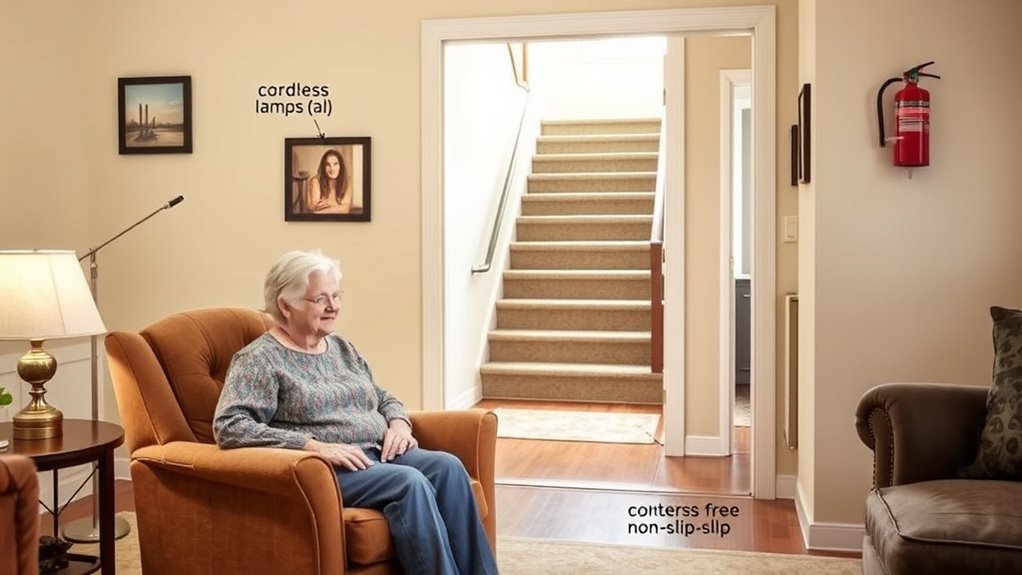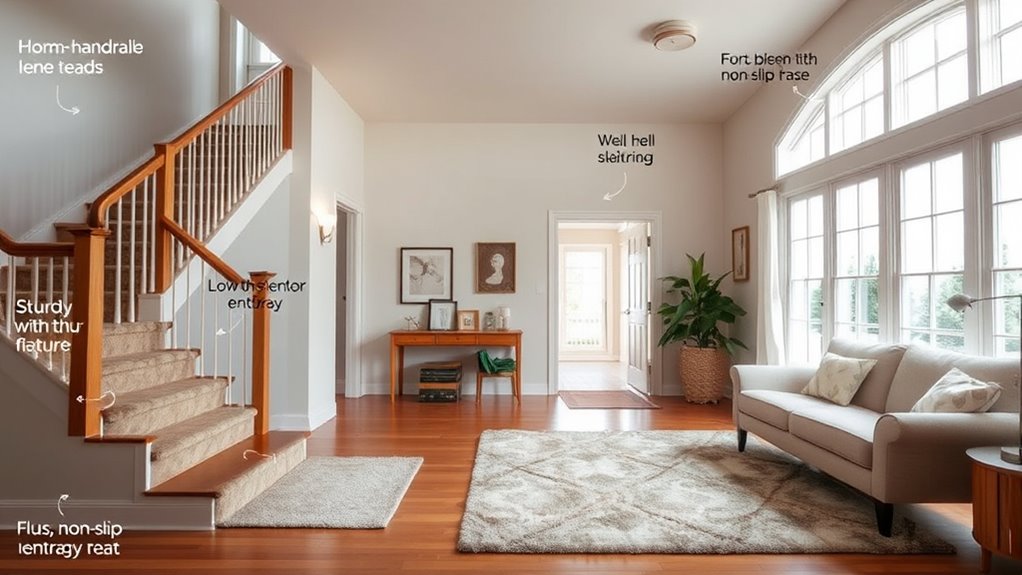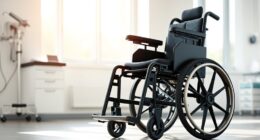To keep your home safe while aging in place, regularly check smoke alarms, keep pathways clear, and install nightlights for better visibility. Create an emergency plan with easy access to contacts and keep a well-stocked emergency kit nearby. Make sure ventilation is good and flammable items are stored safely. Practice emergency drills often, review your plan regularly, and stay informed about safety updates. Continuing forward, you’ll find practical tips to make your home even safer and more comfortable.
Key Takeaways
- Regularly test and maintain smoke alarms and fire extinguishers throughout the home.
- Keep walkways clear, install nightlights, and ensure easy navigation to prevent falls.
- Develop and practice an emergency plan with accessible contacts and emergency supplies.
- Remove hazards, such as loose rugs and clutter, to promote a safe living environment.
- Keep important documents and emergency kits in easy-to-reach, organized locations.

As you age in your own home, guaranteeing safety becomes an essential part of maintaining independence and peace of mind. One of the most critical aspects of safety is fire prevention. You should regularly check your smoke alarms to make sure they’re functioning correctly, replacing batteries at least once a year or as needed. Consider installing interconnected alarms so that if one detects smoke, all alarms sound, providing an early warning. Keep fire extinguishers accessible in key areas like the kitchen, and make sure you know how to use them. Avoid overloading circuits, and never leave cooking unattended, as kitchen fires are common among older adults. Additionally, keep flammable items away from heat sources, and ensure your home has proper ventilation to reduce fire risks.
Emergency preparedness is equally crucial for aging in place. Create a clear, accessible plan for emergencies, including fires, medical issues, or natural disasters. Keep a list of emergency contacts visible and within easy reach, including neighbors, family members, and local emergency services. Have a well-stocked emergency kit in a convenient spot with essentials like water, non-perishable food, medications, a flashlight, batteries, and a first aid kit. Make sure your home is easy to navigate in case you need to evacuate quickly—keep walkways clear and install nightlights to prevent falls in dark areas. Consider having a personal emergency response system or a mobile phone with emergency contacts programmed in, so you can summon help if needed.
Regularly review and update your emergency plan to account for any changes in your health or living situation. Practice emergency drills so that you’re familiar with what to do in different scenarios. Keep important documents like identification, insurance papers, and medical records in a safe, easy-to-access location. When it comes to fire prevention and emergency preparedness, being proactive makes all the difference. Small steps like installing smoke alarms, having a fire extinguisher, and planning for emergencies not only protect your home but also give you confidence that you can handle unexpected situations. Staying prepared helps you maintain independence longer and ensures that you’re ready to respond swiftly should an emergency arise, giving you peace of mind as you age comfortably in your home.
Frequently Asked Questions
How Often Should Safety Audits Be Performed at Home?
You should perform a home inspection and safety assessment at least every six months. Regular safety audits help you identify potential hazards early, ensuring your environment remains safe as your needs change. By staying proactive, you prevent accidents and maintain independence. Keep a checklist handy, and don’t hesitate to do a quick safety assessment after any home modifications or significant events to keep your space secure and aging in place comfortably.
Are There Affordable Options for Home Modifications?
Yes, there are plenty of affordable modifications and budget-friendly upgrades you can make to improve safety at home. You can install grab bars in bathrooms, add non-slip mats, or swap out doorknobs for lever handles without breaking the bank. Look for secondhand options or DIY projects to save even more. These small changes can make a big difference, helping you stay safe without overspending.
Can I Implement Safety Features Myself or Need Professional Help?
In summary, you can definitely handle some DIY safety upgrades, but for more complex changes, it’s wise to get a professional assessment. Think of it like fixing a vintage radio—some tasks are simple enough to do yourself, but others require expert hands. Start with small improvements, like installing grab bars, then consult a professional for major modifications to ensure everything’s safe and up to code.
What Are the Signs That My Home Is No Longer Safe?
You’ll notice safety issues like frequent tripping or falling, which indicate fall prevention needs. Watch for fire hazards such as overloaded outlets or blocked escape routes. If you see loose handrails, uneven flooring, or clutter blocking exits, your home isn’t safe anymore. Address these hazards promptly to prevent accidents. Regularly inspect your space and stay alert for signs that your home requires updates to maintain a secure environment.
How Do I Involve Family in Safety Planning?
You might think safety is a solo job, but involving family makes it stronger. Use open family communication to share concerns and ideas, turning safety into a team effort. Assign shared responsibilities, like checking smoke alarms or clearing clutter, so everyone feels involved. Ironically, the more you include loved ones, the safer your home becomes, proving that safety truly thrives on teamwork and honest conversations.
Conclusion
Remember, safety is a journey, not a destination. By regularly checking your home and making necessary adjustments, you create a secure environment where you can age comfortably and confidently. Don’t wait for accidents to happen—prevention is key. As the saying goes, “An ounce of prevention is worth a pound of cure.” Take small steps today to protect yourself tomorrow, ensuring your home remains a safe haven as you age in place.









